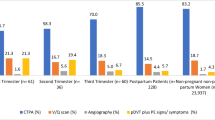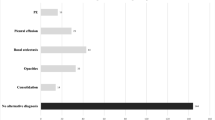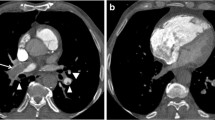Abstract
Study Objectives
Validated clinical pretest probability tools are lacking in the diagnosis of pulmonary embolism (PE) in pregnancy, and the negative predictive value of D-dimers in this population has not been appropriately tested. The goal of this study was to evaluate outcomes of negative multidetector computed tomography with pulmonary angiography (MDCT-PA) for the diagnosis of PE in pregnancy in the absence of such measures.
Methods
Imaging and medical record data, including clinical presentation, risk factors, and all imaging studies performed for the diagnosis of venous thromboembolism (VTE), of 343 pregnant women with PE were reviewed retrospectively. The imaging was performed at a large tertiary-care women’s hospital between 2004 and 2008 using the same-generation MDCT scanner. Primary outcome measure was the occurrence of VTE events 3 months following MDCT-PA or 6 weeks postpartum (whichever came later).
Results
Dyspnea (75.6%) and chest pain (45.6%) were the most common complaints. Fifty-seven percent of patients had at least one additional risk factor other than pregnancy. Body mass index >30 was the most common risk factor (49%). Eight scans were positive for PE and one patient with a negative MDCT-PA had a positive upper-extremity ultrasound, yielding a diagnosis of VTE in 2.9%. Negative scans were technically adequate in 79.1%, technically limited in 20%, and inconclusive in 0.9%. Follow-up showed no symptomatic VTE events after index imaging.
Conclusion
This study showed that MDCT-PA may safely exclude clinically significant PE in pregnancy.
Similar content being viewed by others
References
Heit JA, Kobbervig CE, James AH, Petterson TM, Bailey KR, Melton LJ 3rd (2005) Trends in the incidence of venous thromboembolism during pregnancy or postpartum: a 30-year population-based study. Ann Intern Med 143:697–706
EURO-PERISTAT Project with SCPE, EUROCAT, EURONEOSTAT, European Perinatal Health Report. http://www.europeristat.com/bm.doc/european-perinatal-health-report.pdf. Accessed 8 Apr 2010)
Panting-Kemp A, Geller SE, Nguyen T, Simonson L, Nuwayhid B, Castro L (2000) Maternal deaths in an urban perinatal network, 1992–1998. Am J Obstet Gynecol 183:1207–1212
Sullivan EA, Ford JB, Chambers G, Slaytor EK (2004) Maternal mortality in Australia 1973–1996. Aust N Z J Obstet Gynaecol 44:452–457
Boehlen F, Epiney M, Boulvain M, Irion O, de Moerloose P (2005) Changes in d-dimer levels during pregnancy and the postpartum period: results of two studies. Rev Med Suisse 1:296–298
Eichinger S (2003) d-dimer testing in pregnancy. Pathophysiol Haemost Thromb 33:327–329
Bourjeily G, Paidas M, Khalil H, Rosene-Montella K, Rodger M (2010) Pulmonary embolism in pregnancy. Lancet 375:500–512
Bourjeily G, Chalhoub M, Phornphutkul C, Alleyne TC, Woodfield CA, Chen KK (2010) Neonatal thyroid function: effect of a single exposure to iodinated contrast medium in utero. Radiology 256:744–750
Shahir K, Goodman LR, Tali A, Thorsen KM, Hellman RS (2010) Pulmonary embolism in pregnancy: CT pulmonary angiography versus perfusion scanning. AJR Am J Roentgenol 195:W214–W220
Gherman RB, Goodwin TM, Leung B, Byrne JD, Hethumumi R, Montoro M (1999) Incidence, clinical characteristics, and timing of objectively diagnosed venous thromboembolism during pregnancy. Obstet Gynecol 94:730–734
Ray JG, Chan WS (1999) Deep vein thrombosis during pregnancy and the puerperium: a meta-analysis of the period of risk and the leg of presentation. Obstet Gynecol Surv 54:265–271
Bourjeily G, Khalil H, Rodger M (2010) Pulmonary embolism in pregnancy–Authors’ reply. Lancet 375:1778–1779
MacGillavry MR, Sanson BJ, Buller HR, Brandjes DP (2000) Compression ultrasonography of the leg veins in patients with clinically suspected pulmonary embolism: is a more extensive assessment of compressibility useful? Thromb Haemost 84:973–976
Torres JA, Aracil E, Puras E, Utrilla A, Bernal C, Gandarias C, Ocana J, Haurie J, Perera M, Cuesta C (1999) Role of venous duplex imaging of lower extremity for pulmonary embolism diagnosis. Angiologia 51:71–76
Turkstra F, Kuijer PM, van Beek EJ, Brandjes DP, ten Cate JW, Buller HR (1997) Diagnostic utility of ultrasonography of leg veins in patients suspected of having pulmonary embolism. Ann Intern Med 126:775–781
Barrellier M, Lezin B, Landy S, Le Hello C (2001) Prevalence of duplex ultrasonography detectable venous thrombosis in patients with suspected or acute pulmonary embolism. J Mal Vasc 26:23–30 (in French)
British Thoracic Society Standards P of Care Committee D pulmonary Embolism Guideline development Group (2003) British Thoracic Society guidelines for the management of suspected acute pulmonary embolism. Thorax 58:470–484
James AH, Tapson VF, Goldhaber SZ (2005) Thrombosis during pregnancy and the postpartum period. Am J Obstet Gynecol 193:216–219
Kuiper JW, Geleijns J, Matheijssen NA, Teeuwisse W, Pattynama PM (2003) Radiation exposure of multi-row detector spiral computed tomography of the pulmonary arteries: comparison with digital subtraction pulmonary angiography. Eur Radiol 13:1496–1500
Revel MP, Sanchez O, Dechoux S, Couchon S, Frija G, Cazejust J, Chatellier G, Meyer G (2008) Contribution of indirect computed tomographic venography to the diagnosis of postpartum venous thromboembolism. J Thromb Haemost 6:1478–1481
Winer-Muram HT, Boone JM, Brown HL, Jennings SG, Mabie WC, Lombardo GT (2002) Pulmonary embolism in pregnant patients: fetal radiation dose with helical CT. Radiology 224:487–492
Hopper KD, King SH, Lobell ME, TenHave TR, Weaver JS (1997) The breast: in-plane X-ray protection during diagnostic thoracic CT-shielding with bismuth radioprotective garments. Radiology 205:853–858
Parker MS, Kelleher NM, Hoots JA, Chung JK, Fatouros PP, Benedict SH (2008) Absorbed radiation dose of the female breast during diagnostic multidetector chest CT and dose reduction with a tungsten-antimony composite breast shield: preliminary results. Clin Radiol 63:278–288
Brent R (2001) The pulmonologist’s role in caring for pregnant women with regard to the reproductive risks of diagnostic radiological studies or radiation therapy. Clin Chest Med 32(1):33–42, vii–viii
Groves AM, Yates SJ, Win T et al (2006) CT pulmonary angiography versus ventilation perfusion scintigraphy in pregnancy: implications from a UK survey of doctors’ knowledge of radiation exposure. Radiology 240:765–770
Balan KK, Critchley M, Vedavathy KK, Smith ML, Vinjamuri S (1997) The value of ventilation-perfusion imaging in pregnancy. Br J Radiol 70:338–340
Chan WS, Ray JG, Murray S, Coady GE, Coates G, Ginsberg JS (2002) Suspected pulmonary embolism in pregnancy: clinical presentation, results of lung scanning, and subsequent maternal and pediatric outcomes. Arch Intern Med 162:1170–1175
Litmanovich D, Boiselle PM, Bankier AA, Kataoka ML, Pianykh O, Raptopoulos V (2009) Dose reduction in computed tomographic angiography of pregnant patients with suspected acute pulmonary embolism. J Comput Assist Tomogr 33:961–966
James AH, Jamison MG, Brancazio LR, Myers ER (2006) Venous thromboembolism during pregnancy and the postpartum period: incidence, risk factors, and mortality. Am J Obstet Gynecol 194:1311–1315
Brill-Edwards P, Ginsberg JS, Gent M, Hirsh J, Burrows R, Kearon C, Geerts W, Kovacs M, Weitz JI, Robinson KS, Whittom R, Couture G (2000) Safety of withholding heparin in pregnant women with a history of venous thromboembolism. Recurrence of Clot in This Pregnancy Study Group. N Engl J Med 343:1439–1444
Jacobsen AF, Skjeldestad FE, Sandset PM (2008) Ante- and postnatal risk factors of venous thrombosis: a hospital-based case-control study. J Thromb Haemost 6:905–912
Deutsch AB, Twitty P, Downes K, Parsons MT (2010) Assessment of the alveolar-arterial oxygen gradient as a screening test for pulmonary embolism in pregnancy. Am J Obstet Gynecol 203(4):373.e1-4
Acknowledgments
We thank Gina Ankner, RN, MSN, Beth Hott, and Gwen LaRiviere for their assistance with manuscript preparation. This study was partially funded by the Department of Risk Management at Women and Infants Hospital of Rhode Island (project No. 07-0024, approved March 1, 2007).
Conflict of interest
The authors have no financial ties or conflicts of interest to disclose.
Author information
Authors and Affiliations
Corresponding author
Rights and permissions
About this article
Cite this article
Bourjeily, G., Khalil, H., Raker, C. et al. Outcomes of Negative Multidetector Computed Tomography with Pulmonary Angiography in Pregnant Women Suspected of Pulmonary Embolism. Lung 190, 105–111 (2012). https://doi.org/10.1007/s00408-011-9329-9
Received:
Accepted:
Published:
Issue Date:
DOI: https://doi.org/10.1007/s00408-011-9329-9




